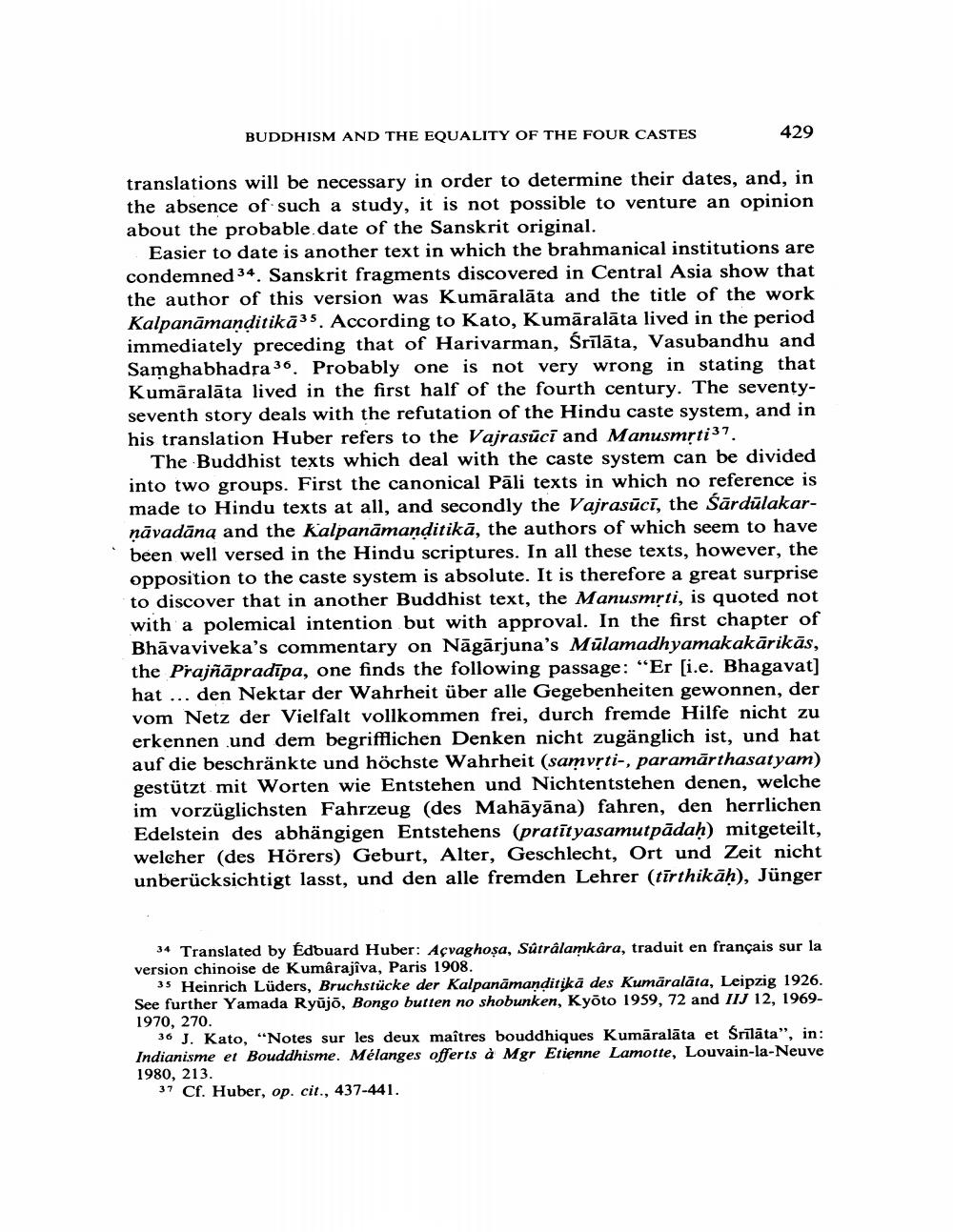Book Title: Buddhism And Equality Of Four Castes Author(s): J W De Jong Publisher: J W De Jong View full book textPage 7
________________ BUDDHISM AND THE EQUALITY OF THE FOUR CASTES 429 translations will be necessary in order to determine their dates, and, in the absence of such a study, it is not possible to venture an opinion about the probable date of the Sanskrit original. Easier to date is another text in which the brahmanical institutions are condemned 34. Sanskrit fragments discovered in Central Asia show that the author of this version was Kumāralāta and the title of the work Kalpanamanditikās. According to Kato, Kumāralāta lived in the period immediately preceding that of Harivarman, Śrīlāta, Vasubandhu and Samghabhadra 36. Probably one is not very wrong in stating that Kumāralāta lived in the first half of the fourth century. The seventyseventh story deals with the refutation of the Hindu caste system, and in his translation Huber refers to the Vajrasuci and Manusmrti". The Buddhist texts which deal with the caste system can be divided into two groups. First the canonical Pāli texts in which no reference is made to Hindu texts at all, and secondly the Vajrasuci, the Sardulakarṇāvadāna and the Kalpanamanditikā, the authors of which seem to have been well versed in the Hindu scriptures. In all these texts, however, the opposition to the caste system is absolute. It is therefore a great surprise to discover that in another Buddhist text, the Manusmrti, is quoted not with a polemical intention but with approval. In the first chapter of Bhāvaviveka's commentary on Nägärjuna's Mulamadhyamakakārikās, the Prajñāpradipa, one finds the following passage: "Er [i.c. Bhagavat] hat... den Nektar der Wahrheit über alle Gegebenheiten gewonnen, der vom Netz der Vielfalt vollkommen frei, durch fremde Hilfe nicht zu erkennen und dem begrifflichen Denken nicht zugänglich ist, und hat auf die beschränkte und höchste Wahrheit (samvṛti-, paramärthasatyam) gestützt mit Worten wie Entstehen und Nichtentstehen denen, welche im vorzüglichsten Fahrzeug (des Mahāyāna) fahren, den herrlichen Edelstein des abhängigen Entstehens (pratityasamutpādaḥ) mitgeteilt, welcher (des Hörers) Geburt, Alter, Geschlecht, Ort und Zeit nicht unberücksichtigt lasst, und den alle fremden Lehrer (tirthikāḥ), Jünger 34 Translated by Edouard Huber: Açvaghosa, Sûtrâlamkâra, traduit en français sur la version chinoise de Kumârajîva, Paris 1908. 35 Heinrich Lüders, Bruchstücke der Kalpanamanḍitikā des Kumāraläta, Leipzig 1926. See further Yamada Ryujō, Bongo butten no shobunken, Kyoto 1959, 72 and IIJ 12, 19691970, 270. 36 J. Kato, "Notes sur les deux maîtres bouddhiques Kumāralāta et Śrīlāta", in: Indianisme et Bouddhisme. Mélanges offerts à Mgr Etienne Lamotte, Louvain-la-Neuve 1980, 213. 37 Cf. Huber, op. cit., 437-441.Page Navigation
1 ... 5 6 7 8 9
